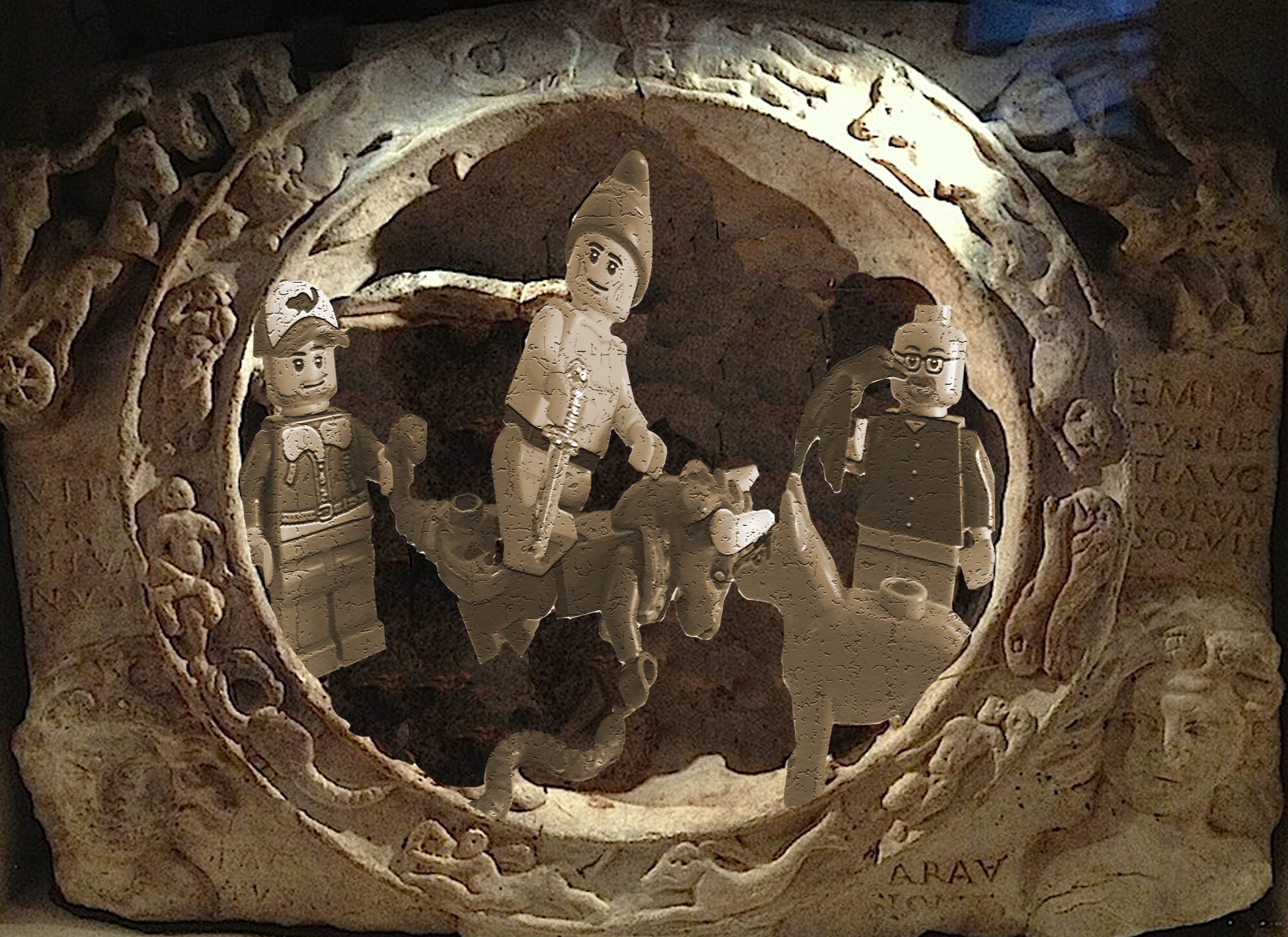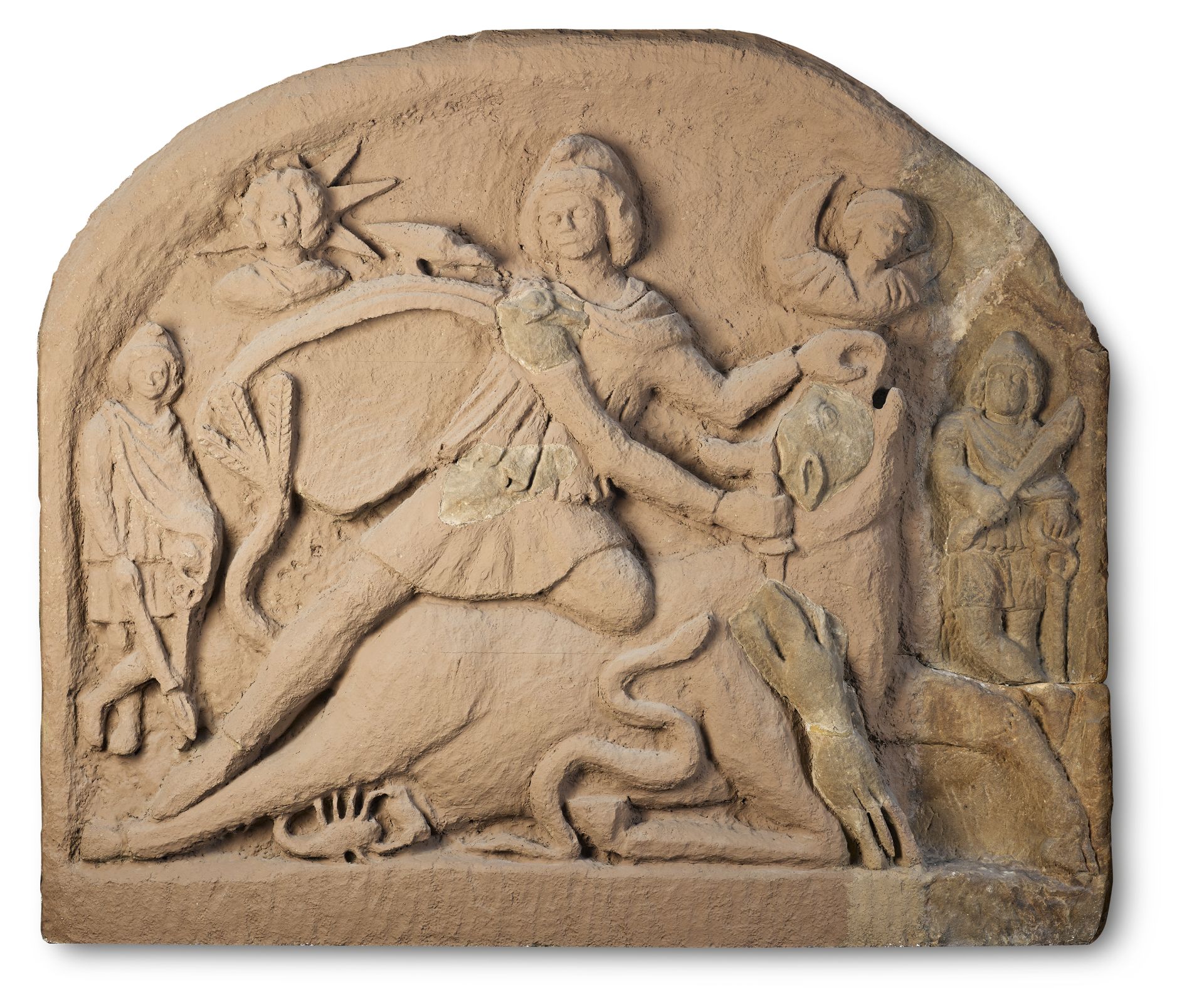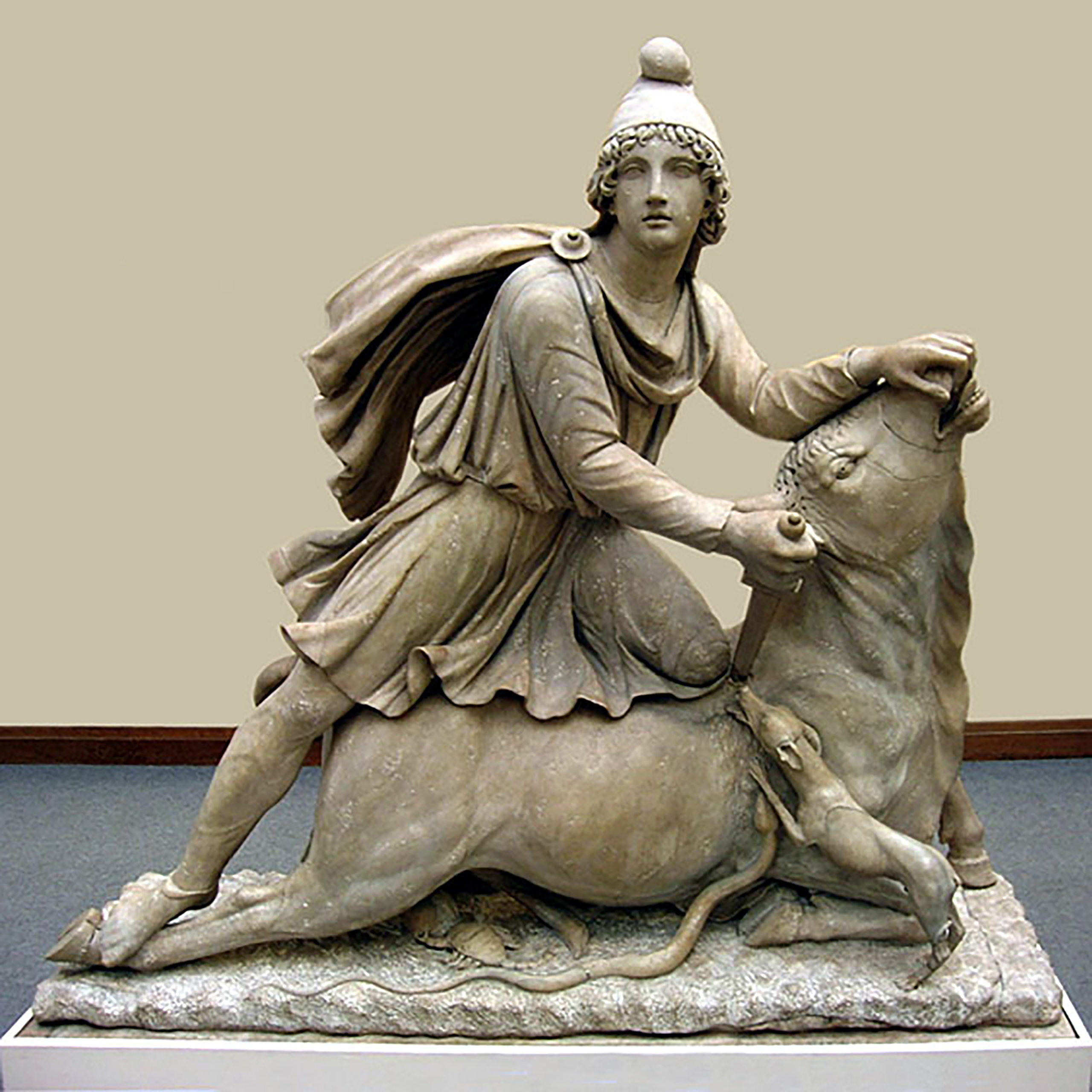Mithra, an enigmatic deity revered in the Roman Empire, offers a fascinating glimpse into the religious landscape of the ancient world. This enigmatic cult, shrouded in mystery and symbolism, captured the hearts and minds of soldiers, civilians, and even emperors, leaving an enduring legacy that continues to intrigue scholars and historians to this day.
From its origins in the East to its widespread popularity in the West, Mithraism left an indelible mark on Roman society, influencing art, literature, and even the development of Christianity. Join us as we delve into the captivating world of Mithra, exploring its beliefs, rituals, and the enduring legacy it left behind.
Origin and History
The origins of the Mithraic cult remain shrouded in mystery, with various theories proposed by scholars. One prominent hypothesis traces its roots to ancient Persia, where Mithra was venerated as a divine figure associated with the sun, justice, and contracts. This Persian influence is evident in the iconography and symbolism of the Mithraic cult, such as the depiction of Mithra slaying a bull.
Spread and Development
The Mithraic cult emerged in the Roman Empire during the 1st century CE, gaining popularity among soldiers and civilians alike. It spread rapidly throughout the empire, establishing communities in major cities and along military frontiers. The cult’s popularity reached its peak in the 3rd century CE, when it became one of the most prominent mystery religions in the Roman world.
Geographical Distribution
Mithraic worship was primarily concentrated in the Roman Empire, with a strong presence in areas such as Italy, Gaul, and the Balkans. However, evidence of Mithraic communities has also been found in other parts of Europe, including Britain, Germany, and Spain. The cult also spread to the eastern provinces of the Roman Empire, including Syria, Egypt, and Anatolia.
Religious Beliefs and Practices

Mithraism was a mystery religion that flourished in the Roman Empire from the 1st to the 4th century CE. Its central beliefs revolved around the worship of Mithras, a divine figure associated with the sun, war, and the covenant between humans and the divine.
Mithraists believed in a cosmic struggle between good and evil, with Mithras as the champion of light and truth. They practiced a variety of rituals and ceremonies, including initiation rites, communal meals, and animal sacrifices.
Role of Mithras
Mithras was a complex and multifaceted deity. He was often depicted as a young man wearing a Phrygian cap and holding a torch or a sword. He was believed to be the mediator between the divine and the human realms, and his cult offered hope of salvation and immortality to its followers.
Examine how Jennifer Lopez can boost performance in your area.
Mithraic Symbolism and Iconography
Mithraic art and artifacts are rich in symbolism and imagery that provide insights into the beliefs and practices of the Mithraic cult.
Tauroctony Scene
The most prominent symbol in Mithraic art is the tauroctony scene, which depicts Mithra slaying a bull. This scene has been interpreted in various ways, including:
* The triumph of good over evil, as Mithra represents the forces of light and the bull symbolizes darkness.
* The sacrifice of the divine to ensure the fertility of the earth.
* The initiation of new members into the Mithraic cult.
Other Symbols
Other important symbols in Mithraic art include:
* Torchbearers: Two torchbearers flank Mithra in the tauroctony scene, representing the opposing forces of light and darkness.
* Serpent: A serpent is often depicted coiled around the bull’s body, representing the forces of chaos and evil.
* Raven: A raven is sometimes shown perched on Mithra’s shoulder, symbolizing wisdom and prophecy.
* Dog: A dog is often present in the tauroctony scene, representing loyalty and protection.
| Symbol | Meaning | Frequency |
|---|---|---|
| Tauroctony | Triumph of good over evil, sacrifice, initiation | High |
| Torchbearers | Light and darkness | High |
| Serpent | Chaos and evil | Medium |
| Raven | Wisdom and prophecy | Low |
| Dog | Loyalty and protection | Low |
Relationship to Other Mystery Religions
Mithraic symbolism shares similarities with other mystery religions, such as the cult of Isis and the Eleusinian Mysteries. These similarities suggest that Mithraism was part of a broader trend towards mystery cults that offered spiritual fulfillment and salvation.
Iconography of Mithraic Temples and Shrines
Mithraic temples and shrines were typically decorated with images of Mithra, the tauroctony scene, and other symbols of the cult. These images were used to create a sacred space where devotees could connect with the divine.
Mithraic Mysteries and Initiations
Mithraic mysteries were secret religious rituals central to the cult of Mithras. Initiates underwent a series of progressive initiations that symbolized their spiritual journey and connection with Mithras.
Levels of Initiation
Mithraic initiations were divided into seven grades, each with its own unique rituals and teachings:
- Raven: Novices who assisted with temple duties
- Bridegroom: Entered the cult and received basic teachings
- Soldier: Swore an oath of loyalty to Mithras
- Lion: Experienced symbolic trials and tribulations
- Persian: Learned about Mithras’ cosmic role
- Courier of the Sun: Carried messages between Mithraic communities
- Father: Highest level, representing the closest connection to Mithras
Purpose and Significance
Initiation rituals served multiple purposes:
- Spiritual purification and rebirth
- Transmission of secret knowledge and teachings
- Strengthening of bonds within the Mithraic community
- Preparation for the afterlife and connection with Mithras
Comparative Analysis
Mithraic initiations shared similarities with other mystery religions of the time:
- Secrecy and exclusivity: Initiates were sworn to secrecy and only a select few reached the highest levels.
- Symbolic trials: Candidates underwent physical and psychological challenges to test their worthiness.
- Divine revelation: Initiates received secret knowledge and insights into the nature of the divine.
However, Mithraism also had unique aspects, such as its focus on the sun god Mithras and its military symbolism.
Mithraism and Roman Society
Mithraism, a mystery religion originating in ancient Persia, played a significant role in Roman society, interacting with the political, social, and religious structures of the empire.
Mithraism and the Roman Empire
Mithraism gained popularity among Roman soldiers and civilians, who were drawn to its emphasis on loyalty, discipline, and personal salvation. The cult’s rituals and beliefs resonated with Roman values of honor, duty, and the afterlife.
- Mithraic sanctuaries were often found near military camps, suggesting a strong connection between the cult and the army.
- Mithra was depicted as a warrior god, embodying the virtues of courage and strength, which appealed to Roman soldiers.
Impact on Roman Culture and Society
Mithraism left a lasting impact on Roman culture and society, influencing art, literature, and religious practices.
- Mithraic imagery and symbolism can be found in Roman art, including sculptures, mosaics, and paintings.
- Mithraic beliefs influenced Roman literature, particularly in the works of authors such as Apuleius and Tertullian.
- Mithraic sanctuaries were often used as gathering places for religious ceremonies and social events, contributing to community life.
Decline of Mithraism
Despite its popularity, Mithraism declined in the late Roman Empire, primarily due to the rise of Christianity.
- Christianity offered a more universal message of salvation and appealed to a broader audience.
- Mithraism was perceived as a foreign cult, while Christianity was seen as more closely aligned with Roman traditions.
- Persecution of pagan cults by Christian emperors contributed to the decline of Mithraism.
Mithraism and Christianity
Mithraism and early Christianity emerged during the same historical period and shared some similarities in their beliefs and practices. Both religions emphasized the importance of a savior figure, a belief in life after death, and the practice of initiation rituals. However, there were also significant differences between the two religions.
Comparison of Beliefs and Practices
- Mithraism was a mystery religion that focused on the worship of Mithra, a Persian god of light. Mithraism had a complex system of beliefs that included the concept of a cosmic battle between good and evil.
- Christianity was a monotheistic religion that focused on the worship of Jesus Christ, who was believed to be the son of God. Christianity emphasized the importance of faith, repentance, and salvation.
Possible Influences
Despite their differences, there is evidence that suggests that Mithraism may have had some influence on the development of Christianity. Some scholars believe that the Mithraic concept of a savior figure who dies and is resurrected may have influenced the Christian belief in Jesus’ resurrection. Additionally, some Mithraic symbols and rituals appear to have been adopted by early Christians.
Mithraism and Christian Iconography and Theology
The influence of Mithraism on Christian iconography and theology is still debated among scholars. Some believe that Mithraic symbols, such as the lamb and the shepherd, were adopted by early Christians. Others argue that these symbols were already present in other ancient religions and that Mithraism had no direct influence on Christianity.
– Describe the architectural features and design of Mithraic temples, including the use of apses, benches, and altars
Mithraic temples were typically small, underground structures known as mithraea. They were often located in caves or cellars and were designed to create a sense of mystery and intimacy. The temples were typically divided into three main sections: the antechamber, the cella, and the apse.
The antechamber was the entrance to the temple and was often used for gatherings and socializing. The cella was the main chamber of the temple and was where the Mithraic rituals were performed. The apse was a small, semicircular room at the back of the cella and was where the statue of Mithras was kept.
The temples were often decorated with elaborate frescoes and sculptures depicting Mithras and other deities. The walls were often lined with benches for the worshippers to sit on during the rituals. The altars were used for sacrifices and were often decorated with the symbols of Mithras.
Use of apses, benches, and altars
The use of apses, benches, and altars in Mithraic temples was significant for several reasons. The apse was a sacred space where the statue of Mithras was kept. The benches were used by the worshippers to sit on during the rituals. The altars were used for sacrifices and were often decorated with the symbols of Mithras.
The use of these elements in Mithraic temples helped to create a sense of mystery and intimacy. The apses were often decorated with elaborate frescoes and sculptures, which helped to create a sense of awe and wonder. The benches were used by the worshippers to sit on during the rituals, which helped to create a sense of community. The altars were used for sacrifices, which helped to create a sense of connection to the divine.
Mithraic Festivals and Celebrations
Mithraic festivals and celebrations played a vital role in the religious life of the cult. These events provided opportunities for Mithraists to come together, engage in communal rituals, and honor the god Mithra. The Mithraic calendar featured several important festivals, each with its unique rituals and traditions.
Festival of the Nativity
The Festival of the Nativity, also known as the Winter Solstice, marked the birth of Mithra on December 25th. It was celebrated with the lighting of candles, the offering of gifts, and the exchange of greetings. Mithraists believed that Mithra was born in a cave, and they often decorated their Mithraea with nativity scenes depicting this event.
Mithraism in Popular Culture

Mithraism has left a lasting impression on Western culture, influencing literature, art, and film. Its enigmatic rituals and iconography have captured the imagination of artists and writers for centuries.
Obtain direct knowledge about the efficiency of Flying spiders through case studies.
Influence on Literature
Mithraism has been a source of inspiration for literary works, from ancient Roman texts to modern fantasy novels. In the 2nd century CE, the Roman philosopher Apuleius wrote “The Golden Ass,” which includes a detailed description of Mithraic mysteries. More recently, the fantasy writer Michael Moorcock has incorporated Mithraic elements into his “Elric of Melniboné” series.
Influence on Art
Mithraic iconography has been a popular subject for artists throughout history. Roman mosaics, sculptures, and frescoes often depict Mithras slaying the bull or other scenes from Mithraic mythology. In the Renaissance, artists such as Michelangelo and Raphael incorporated Mithraic motifs into their works.
Influence on Film
Mithraism has also had an impact on film. The 1960 film “Spartacus” features a scene in which the titular character is initiated into a Mithraic cult. More recently, the 2000 film “Gladiator” includes a brief depiction of a Mithraic temple.
Modern-Day Organizations
In recent years, there has been a resurgence of interest in Mithraism. Several modern-day organizations draw inspiration from its teachings and rituals. These groups include:
- The Mithraic Society
- The Mithraeum
- The Order of Mithras
Role in Contemporary Spirituality
Mithraism continues to play a role in contemporary spirituality and neopaganism. Some practitioners incorporate Mithraic beliefs and practices into their own spiritual journeys. Mithraism’s emphasis on personal transformation, courage, and loyalty resonates with many modern seekers.
Archaeological Evidence for Mithraism

Archaeological discoveries have played a crucial role in shedding light on the practices, beliefs, and spread of Mithraism. Excavations of Mithraic temples, artifacts, and inscriptions have provided valuable insights into the religious rituals, iconography, and social significance of this ancient mystery cult.
Archaeological Discoveries
Significant archaeological discoveries related to Mithraism include:
* Temple of Mithras, London (c. 2nd-3rd century CE): One of the best-preserved Mithraic temples, featuring an apse, benches, and an elaborate Mithraic relief depicting the tauroctony (slaying of the bull).
* Mithraeum of Santa Prisca, Rome (c. 2nd-3rd century CE): A Mithraic temple built within the Baths of Trajan, showcasing a fresco of the tauroctony and other Mithraic imagery.
* Mithraeum of Marino, Italy (c. 2nd-3rd century CE): A Mithraic temple adorned with reliefs depicting the seven grades of Mithraic initiation and the journey of the soul.
* Mithraeum of Dieburg, Germany (c. 3rd-4th century CE): A large Mithraic temple complex with an apse, benches, and a monumental Mithraic relief.
* Mithraeum of Carrawburgh, England (c. 2nd-3rd century CE): A Mithraic temple located on Hadrian’s Wall, featuring a well-preserved Mithraic relief and inscriptions.
Significance of Artifacts and Monuments
Mithraic artifacts and monuments provide valuable information about the cult’s practices and beliefs:
* Tauroctony reliefs: Depictions of Mithras slaying the bull symbolize the victory of good over evil and the initiation of Mithraic devotees.
* Inscriptions: Inscriptions found in Mithraic temples record the names of Mithraic initiates, the dedication of temples, and the cult’s organizational structure.
* Votive offerings: Offerings found in Mithraic temples, such as coins, statuettes, and lamps, indicate the piety and devotion of Mithraic worshippers.
Timeline of Archaeological Discoveries
* 16th century: First Mithraic temple discovered in Rome.
* 17th century: Mithraic reliefs and inscriptions discovered in England.
* 18th century: Systematic excavations of Mithraic temples in Germany and France.
* 19th century: Discovery of the Mithraeum of Santa Prisca in Rome.
* 20th century: Excavations of Mithraic temples in Britain, Germany, and elsewhere.
* 21st century: Ongoing archaeological research on Mithraism, including the use of new technologies like ground-penetrating radar.
Major Archaeological Sites
| Site | Location | Dates of Excavation | Key Discoveries |
|—|—|—|—|
| Mithraeum of London | London, England | 1954-1955 | Mithraic relief, benches, apse |
| Mithraeum of Santa Prisca | Rome, Italy | 1882-1884 | Mithraic fresco, Mithraic reliefs |
| Mithraeum of Marino | Marino, Italy | 1935-1936 | Mithraic reliefs depicting initiation grades |
| Mithraeum of Dieburg | Dieburg, Germany | 1998-2004 | Mithraic relief, apse, benches |
| Mithraeum of Carrawburgh | Carrawburgh, England | 1964-1967 | Mithraic relief, inscriptions |
Archaeological Evidence Essay
The archaeological evidence for Mithraism provides a rich tapestry of information about the practices, beliefs, and social significance of this ancient mystery cult. Excavations of Mithraic temples, artifacts, and inscriptions have revealed the widespread nature of the cult, its elaborate rituals, and its influence on Roman society.
The Mithraic temples, with their distinctive apses, benches, and altars, served as sacred spaces for the initiation of devotees and the performance of Mithraic rituals. The tauroctony reliefs, depicting Mithras slaying the bull, symbolize the central myth of the cult and the triumph of good over evil.
Inscriptions and votive offerings provide insights into the organizational structure of Mithraism, the names of its initiates, and the piety of its worshippers. The timeline of archaeological discoveries shows the gradual increase in our knowledge of Mithraism, from its initial discovery in the 16th century to ongoing research in the 21st century.
The archaeological evidence for Mithraism has played a crucial role in reconstructing the history and practices of this ancient cult. It has shed light on the beliefs, rituals, and social significance of Mithraism, providing valuable insights into the religious landscape of the Roman Empire.
– Analyze the primary sources that provide information about Mithraism, such as archaeological remains, inscriptions, and sculptures.

Primary sources for Mithraism include archaeological remains such as temples, inscriptions on altars and statues, and sculptures depicting Mithraic scenes. These sources provide valuable insights into the beliefs, practices, and iconography of the cult.
Archaeological remains, such as Mithraic temples, offer physical evidence of the cult’s existence and practices. Temples typically featured an apse, where the statue of Mithra was placed, and benches for participants. Inscriptions on altars and statues provide information about the deities worshipped, the names of Mithraic priests, and the rituals performed.
Sculptures, Mithra
Sculptures are another important source of information about Mithraism. Depictions of Mithra slaying the bull, known as the tauroctony, are common in Mithraic iconography. These sculptures provide visual representations of the central myth of the cult and offer insights into the symbolism and meaning behind the ritual.
Mithraism and Gender
Mithraism, like many other ancient religions, was primarily a male-dominated cult. Women were generally excluded from participating in the religious ceremonies and rituals. However, there is some evidence to suggest that women did play a role in Mithraism, albeit a limited one.
Female Deities and Priestesses
There is evidence of female deities being worshipped within the Mithraic cult. One such deity was Mithra’s consort, known as Mithras Mater or Dea Mithra. She was often depicted as a young woman wearing a Phrygian cap and holding a torch or a cornucopia. Another female deity associated with Mithraism was Nike, the goddess of victory. She was often depicted standing on a globe, symbolizing Mithra’s triumph over evil.
While there is evidence of female deities being worshipped, there is little evidence to suggest that women held any official priestly roles within the Mithraic cult. The vast majority of known Mithraic priests were men. However, there is some evidence to suggest that women may have served as priestesses in some Mithraic communities. One inscription from the Roman city of Ostia refers to a “priestess of Mithras” named Julia Crescentia.
Gender Dynamics
The gender dynamics within the Mithraic cult were complex and varied. While women were generally excluded from participating in the religious ceremonies and rituals, there is evidence to suggest that they did play a role in the cult, albeit a limited one. The worship of female deities and the possibility of female priestesses suggest that women were not entirely excluded from Mithraism. However, it is clear that the cult was primarily a male-dominated institution.
Mithraism and the Environment
Mithraism, an ancient mystery religion centered around the worship of Mithras, held a deep connection with nature and the environment. Its iconography, rituals, and sanctuaries reflect a profound reverence for the natural world and its elements.
Symbolism of Animals, Plants, and Elements
Mithraic iconography is replete with symbols of animals, plants, and the elements. The bull, a central figure in Mithraic mythology, represents fertility and strength. Lions, often depicted flanking Mithras, symbolize courage and kingship. The serpent, entwined around the bull’s body, represents wisdom and eternity. Plants such as the vine and the fig tree symbolize life and abundance. The elements of fire, water, earth, and air are also frequently depicted, representing the cosmic forces that govern the natural world.
Environmental Values and Practices
Mithraic followers held strong environmental values. They believed in the sacredness of natural landscapes and the importance of preserving them. Mithraic sanctuaries were often located in secluded, natural settings, such as caves or groves, creating a sense of reverence and connection with the natural world. Rituals and initiations often incorporated elements of nature, such as water purification and the use of natural materials like animal skins and plants.
Mithraic Sanctuaries and Natural Landscapes
Mithraic sanctuaries played a significant role in preserving natural landscapes. By establishing sanctuaries in secluded and often pristine areas, Mithraists helped protect these environments from encroachment and exploitation. The sanctuaries became havens for wildlife and plant life, contributing to the overall ecological balance of the region.
Influence on Ecological Thought
Mithraism’s emphasis on the sacredness of nature and the importance of preserving it had a profound influence on the development of ecological thought in the ancient world. Mithraic teachings fostered a sense of stewardship and responsibility towards the environment, promoting a harmonious relationship between humans and the natural world.
Comparison with Other Ancient Religions
Compared to other ancient religions, Mithraism placed a unique emphasis on the environment. While many religions acknowledged the importance of nature, Mithraism went beyond mere acknowledgment, actively incorporating environmental values into its beliefs and practices. Mithraic sanctuaries served as sanctuaries for wildlife and plant life, contributing to the preservation of natural landscapes.
Mithraism and the Military
Mithraism, a mystery religion that originated in the Roman Empire, gained significant popularity among Roman soldiers. The cult’s appeal to military personnel can be attributed to several factors.
Reasons for the Cult’s Appeal
– Mithraism emphasized loyalty, discipline, and camaraderie, virtues highly valued in the military.
– The cult’s rituals and ceremonies provided a sense of belonging and purpose, especially for soldiers who were often far from home and family.
– Mithra was often depicted as a warrior god, which resonated with soldiers who saw themselves as protectors of the empire.
– Elaborate on the Mithraic beliefs about death and the afterlife, including their views on the soul’s journey and the nature of the afterlife realm.
The Mithraic beliefs about death and the afterlife were intricate and held a central place in their religious system. They believed that upon death, the soul embarked on a perilous journey through the celestial spheres, facing various trials and challenges along the way.
The soul’s ultimate destination was the realm of Mithras, a paradise where the faithful would enjoy eternal bliss. However, to reach this paradise, the soul had to overcome numerous obstacles and temptations, which included crossing a treacherous bridge guarded by demons and navigating a labyrinth of darkness.
The Bull-Slaying Scene and Cosmic Renewal
The iconic bull-slaying scene, often depicted in Mithraic iconography, held profound symbolic significance in this context. It represented the sacrifice of the divine bull by Mithras, an act that was believed to have brought about the creation of the cosmos and the redemption of humanity.
The bull’s blood was seen as a life-giving force that purified the soul and granted it the strength to overcome the challenges of the afterlife journey. The slaying of the bull also symbolized the triumph of good over evil and the promise of cosmic renewal.
Salvation and Eternal Life
The Mithraic concept of salvation was closely tied to the idea of eternal life. Through the rituals and practices of the cult, initiates sought to purify themselves and gain favor with Mithras, thereby ensuring their place in the afterlife paradise.
Initiation into the Mithraic mysteries involved a series of seven grades, each associated with a specific planet and a particular celestial sphere. As initiates progressed through these grades, they underwent ritual purification and symbolic trials, preparing them for the afterlife journey.
Mithraic Beliefs Compared to Other Mystery Religions
| Mithraism | Eleusinian Mysteries | Orphic Mysteries | |
|---|---|---|---|
| Nature of the Afterlife | Paradise of Mithras, reached through a perilous journey | Elysian Fields, a blissful realm for the initiated | Underworld divided into realms of punishment and reward |
| Role of the Deity | Mithras as savior and guide | Demeter and Persephone as goddesses of the underworld | Orpheus as the guide to the underworld |
| Initiation Rituals | Seven grades with ritual purification and trials | Secret ceremonies involving sacred objects and performances | Purification rituals and mystical teachings |
Primary Source Quote
“To the god Mithras, the invincible sun, the father who alone has created all things, and who alone will preserve all things forever, and who alone will judge all things at the appointed time. I, (name), being about to depart from this life, do commend my soul to thee, O Mithras, and to thy eternal rest. May my soul find favor in thy sight, and may I be received into thy paradise, where the righteous dwell in everlasting bliss.”
– Mithraic inscription from the Mithraeum of Dieburg, Germany
This inscription provides a glimpse into the Mithraic beliefs about the afterlife, emphasizing the importance of Mithras as the savior and judge, and the hope for eternal rest in his paradise.
Conclusive Thoughts

Mithra, the enigmatic god of the Roman Empire, remains a testament to the diversity and complexity of ancient religious beliefs. Its rituals, symbolism, and widespread appeal offer a window into the spiritual and cultural landscape of the ancient world. While the cult of Mithra may have faded into obscurity, its legacy continues to inspire and fascinate, reminding us of the enduring power of faith and the enduring search for meaning in the human experience.